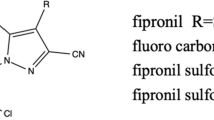Abstract
A polyclonal antibody against ochratoxin A (OTA) was produced from rabbits immunized with the OTA–BSA conjugate. A competitive direct enzyme-linked immunosorbent assay (cdELISA) and a membrane-base colloidal gold immunoassay in flow-through format were developed for the rapid detection of OTA in various food matrices. In the cdELISA, the concentration causing 50% inhibition was 0.07 ng mL−1, and the effects of different chemical conditions (ionic strength, pH value, and organic solvent) were studied. The sensitivity of the assay was higher than those previously reported. A simple, rapid, and efficient extraction method was developed and 74–110% recoveries of spiked samples were obtained. Fifty percent methanol extracts of some food samples such as barley, wheat, oat, corn, rice, and raisins could be analyzed directly by immunoassay after dilution in PBS; grape juice and beer samples could be analyzed directly after dilution with PBS; for coffee samples, a more complex method was used to remove the matrix effect effectively. Membrane-based colloidal gold immunoassays had a visual detection limit of 1.0 ng mL−1 for OTA with a detection time of less than 10 min. For the validation of the cdELISA and membrane-based colloidal gold immunoassay, samples were analyzed by high-performance liquid chromatography. The correlation between data obtained using the microwell assay and HPLC was good (R 2 = 0.984). The developed immunoassay methods are suitable for the rapid quantitative or qualitative determination of OTA in food samples.







Similar content being viewed by others
References
Hong Kong risk assessment studies report (2006) No 23:3–4
Abouzied MM, Horvath AD, Podlesny PM, Regina NP, Metodiev VD, Kamenova-Tozeva RM, Niagolova ND, Stein AD, Petropoulos EA, Ganev VS (2002) Food Addit Contam 19(8):755–764
JECFA (2002) No. 906:28
EU Regulation (2005) No 123/2005, L25:3–5
Palmisano LMF (2004) Anal Bioanal Chem 378:96–103
Jornet D, Busto O, Guasch J (2000) J Chromatogr A 822:29–35
Aboul-Enein HY, Kutluk OB, Altiokka G, Tuncel M (2002) Biomed Chromatogr 16:470–474
Curtui VG, Gareis M (2001) Food Addit Contam 18(7):635–643
Garcia-Villanova RJ, Cordon C, Paramas AMG, Aparicio P, Rosales MEG (2004) J Agric Food Chem 52:7235–7239
Czerwiecki L, Wilczynska G, Kwiecien A (2005) Food Addit Contam 22(2):158–162
Pestka JJ, Steinert BW, Chu FS (1981) Appl Environ Microb 41(6):1472–1474
Rousseau DM, Candlish AAG, Slegers GA, Peteghem CHV, Stimson WH, Smith JE (1987) Appl Environ Microb 53(3):514–518
Clarke JR, Marquardt RR, Oosterveld A, Frohlich AA, Madrid FJ, Dawood M (1993) J Agric Food Chem 41:1784–1789
Barna-Vetro I, Solti L, Teren J, Gyongyosi A, Szabo E, Wolfling A (1996) J Agric Food Chem 44:4070–4074
Thirumala-Devi K, Mayo MA, Reddy G, Reddy SV, Delfosse P, Reddy DVR (2000) J Agric Food Chem 48:5079–5082
Fujii S, Ribeiro RMR, Scholz MBDS, Ono EYS, Prete CEC, Itano EN, Ueno Y, Kawamura O, Hirooka EY (2006) Food Addit Contam 23(9):902–909
Thirumala-Devi K, Mayo MA, Reddy G, Emmanuel KE, Larondelle Y, Reddy DVR (2001) Food Addit Contam 18(9):830–835
Yu FY, Chi TF, Liu BH, Su CC (2005) J Agri Food Chem 53:6947–6953
Morgan MRA, McNerney R, Chan HWS (1983) J Assoc Off Anal Chem 66:1481–1484
Lee SC, Chu FS (1984) J Assoc Off Anal Chem 67:45–49
Cho YJ, Lee DH, Kim DO, Min WK, Bong KT, Lee GG, Seo JH (2005) J Agri Food Chem 53:8447–8451
Wang S, Allan RD, Skerritt JH, Kennedy IR (1998) J Agric Food Chem 46:3330–3338
Wang S, Zhang C, Wang JP, Zhang Y (2005) Anal Chim Acta 546:161–166
Krotzky AJ, Zeeh B (1995) Pesticides report 33. Pure Appl Chem 67:2065–2088
Acknowledgements
The authors are grateful for financial supports from the Ministry of Science and Technology of the People’s Republic of China (project No.2006BAD05A06, 2006AA10Z448), the New Century Talent Program of Ministry of Education of People’s Republic of China (project No. NECT-04-0243).
Author information
Authors and Affiliations
Corresponding author
Rights and permissions
About this article
Cite this article
Wang, XH., Liu, T., Xu, N. et al. Enzyme-linked immunosorbent assay and colloidal gold immunoassay for ochratoxin A: investigation of analytical conditions and sample matrix on assay performance. Anal Bioanal Chem 389, 903–911 (2007). https://doi.org/10.1007/s00216-007-1506-6
Received:
Revised:
Accepted:
Published:
Issue Date:
DOI: https://doi.org/10.1007/s00216-007-1506-6




